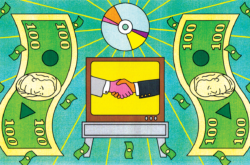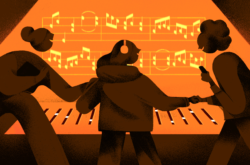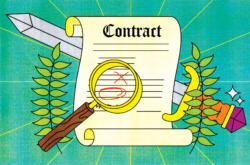The beauty of our post-internet landscape is that it’s still a wild west—a space for artists to reinvent and pioneer new business models.
While gatekeepers are still abound and the power structure that prevails and evolves is something one needs to continually navigate, musicians have access to more streams for revenue today than ever before. In this blog post, let’s explore some fundamental revenue structures that exist for artists and producers in 2021.
Digital distributors
A digital distributor is a service that delivers your music to digital streaming platforms (DSPs) such as Apple Music, Spotify, etc. These companies can range from a boutique independent company of several people to larger, less individualized operations such as Landr, Tunecore, and CD Baby. While there are pros and cons, specialized distributors can carry more weight than a service like Tunecore. For instance, Seed is an indie electronic distributor that works specifically with experimental labels, and the DSPs pay attention to them for being tasteful selectors of this music.
Streaming and digital sales
The rate of revenue per stream varies across DSPs but is relatively low on a surface level. Nonetheless, streaming royalties can amount to significant income, as can digital sales, especially in the realm of playlisting. When tracks enter Spotify or Apple Music playlists, their plays can snowball into the millions, paying your rent and then some if you’re lucky. However, this kind of good fortune is highly dependent on stars aligning that are in many ways ultimately outside of one’s control, such as your digital distributor pitching your work to the right playlist at the right time, and the playlist curator being in an agreeable mood that day.
For detailed information on streaming music service payouts, you can check out The Trichodist’s report here.
Physical sales
For a certain kind of artist with a significant audience (or one geared towards vinyl and tapes), physical manufacturing can service a demand and lend itself to a perceived legitimacy among record heads. The easiest way to explore this avenue is through being signed to a label who works to press records and getting them in stores with their physical distributor (a different entity, and often a different company altogether than a label’s digital distributor). That being said, it isn’t uncommon for producers to self-fund and manufacture physical products to be distributed on an à la carte basis to select retailers, or via a distribution deal to be struck independent of a label.
Record labels
While many artist-label relationships begin organically as friends or the label reaching out to the artist, a thoughtful, friendly, and concise email with streaming and download links of the absolute best work you’d like to release can find success among labels who accept demos.
Live performance and DJing
Although there continue to be restrictions and safety precautions, depending on the nature of your work, live performance and DJing are of course staple practices for artists and producers. While massively helpful and potentially lucrative, these aren’t essential if you’re a producer / songwriter type who’s happier making tracks in the studio.
Merchandise and limited edition works
We’re all familiar with shirts, hoodies, tote bags, and so forth, but limited edition works such as zines and prints can go a long way to offer fans something physical and meaningful beyond the music. An effective model in the world of merchandising in this example is pairing merchandise with a digital download, concert tickets, or some kind of exclusive access.
Licensing
There’s arguably no sweeter deal than having music that you’ve already made synced with a TV show or film that aligns with your taste, in exchange for getting paid a fee plus royalties on the back end to be collected by a performing rights organization (PRO) such as ASCAP, BMI, or SESAC. Read credits and explore Twitter to find the music supervisors of shows and films that operate in a relevant sonic space, and build a relationship as naturally as possible.
Composing for film, TV, and games
Made with multimedia in mind but composed from scratch to spec, music for advertising and film / game scoring are worlds of their own. Look into the countless music houses that produce commercial music around the world that operate with staff composers and increasingly with freelancers. While it’s not an offering all of the time, you can work from home and get paid a demo fee for submitting 15 – 30 seconds of music, or (while rates vary widely depending on the scale of the project) get paid tens of thousands if your track is chosen from a massive pool of hopefuls.
Producing for others and co-writing
If you’re a solo producer with your own project, you might still want to consider producing for others. Similarly, if you’re a singer-songwriter, try your hand at writing in the pop world. The work here is in finding a good match between yourself and a complimentary producer or top-line writer (depending on your role). These collaborative experiences can lead to tremendous growth personally, musically, and socially. Shopping the fruit of your labor to pop A&Rs is a hustle more at home in Los Angeles than anywhere else, in spite of the internet shrinking the physicality of these interactions bit by bit.
Wherever you are in your journey as an artist or producer—from deciding whether to pursue a career in music or already being in the midst of it–exploring every potential avenue and opportunity is a worthy consideration. Finding what works is as an experimental process. Play to your strengths and carve out your own path in what is, after all, one of the most malleable industries to work in.
Explore royalty-free sounds from leading artists, producers, and sound designers:
September 15, 2020



